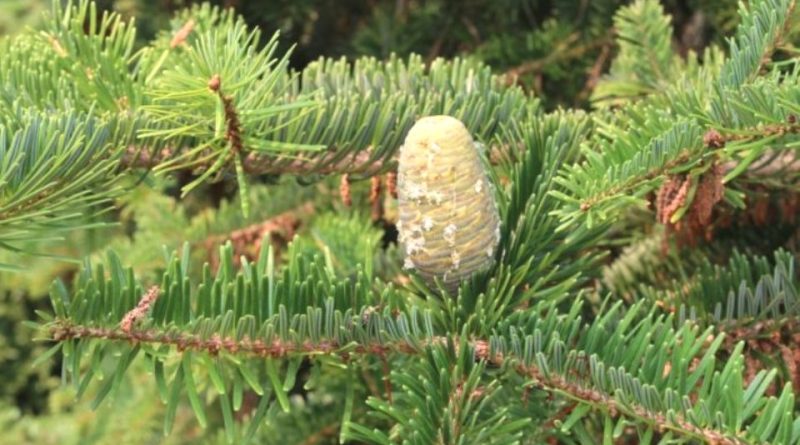Abies chensiensis
Abies chensiensis
Shensi fir (Abies chensiensis Tiegh.) is an arboreal species belonging to the Pinaceae family.
Systematics –
From a systematic point of view it belongs to:
Eukaryota Domain,
Kingdom Plantae,
Pinophyta Division,
Pinopsida class,
Order Pinales,
Pinaceae family,
Genus Abies,
A. chensiensis species
The terms are synonymous:
– Abies salouenensis Bord.-Rey et Gauss.;
– Abies firma Masters;
– Abies shensiensis Pritzel ex Diels.
The following varieties are recognized within this species:
– Abies chensiensis var. salouenensis (Bordères & Gaussen) Silba – endemic variety of the mountains of the Saluen river basin in China and India;
– Abies chensiensis var. yulongxueshanensis (Rushforth) Silba – endemic variety of Yulongxue Shan, in China;
– Abies chensiensis var. ernestii (Rehder) Tang S.Liu – endemic variety of Tibet and China.
Etymology –
The term Abies comes from Abies which is the classical Latin name (Virgil, Egloghe, from the Sanskrit root abh gush of resin); according to another interpretation it would derive from the Greek word ἄβιος = long-lived.
The specific name chensiensis refers to Shaanxi, a province of China where the species was described for the first time.
Geographic Distribution and Habitat –
Abies chensiensis is a plant endemic to south-eastern China and north-eastern India and present in the Chinese regions of Gansu, Henan, Hubei, Shaanxi, Sichuan, Yunnan, Xizang and the India of Arunachal and Uttar Pradesh.
Its habitat is that of high mountain altitudes between 2,000 and 3,500 m, with annual rainfall between 1,000 and 2,000 mm where there are pure woods, but it is often found in association with Abies fargesii, Tsuga chinensis, Larix potaninii and species of the genera Picea and Betula.
Description –
Shensi fir is a tree that can reach a height of 50 m, with a trunk that can reach 2.5 m in diameter.
It has a dark gray and smooth bark when young, which becomes longitudinally fissured with age.
The main branches are massive and short while the secondary branches are yellowish gray to yellow brown and hairless.
The leaves are needle-like, dark green, up to 5 cm long, arranged like a comb in two lateral rows. The buds are conical or ovoid, resinous, 1 cm long and the pearls that cover them are triangular or ovate, red-brown in color.
Male strobili are 1 cm long.
The female ones are initially green, brown when ripe, cylindrical, up to 10 cm long and up to 4 cm broad, with a short peduncle; the scales are ovate-wedge-shaped, 2.5 cm long, 3.5 cm broad, and covered with down. The seeds, brown in color, are about 10 mm long, shaped like an inverted egg, with 2 cm light brown wings, cuneate.
Cultivation –
For the cultivation of this plant it should be taken into account that it grows in cold and humid forests at an altitude between 2,000 and 3,500 m, in regions with annual rainfall of 1,000 to 2,000 mm.
The plant prefers rich, deep and well-drained soils and grows best on protected mountain slopes and mountain valleys.
Its cold resistance is between -10 ° and -17.8 ° C.
Customs and Traditions –
Abies chensiensis is a conifer used and exploited for a long time in northern China, for its easily workable wood, used in construction, in veneers and paneling.
From the ecological point of view it is a species with a very vast range, albeit fragmented, and a very common presence; for this reason the A. chensiensis is classified as least concern in the IUCN Red List. Recently, to limit its overexploitation, the Chinese authorities have placed severe restrictions on the clearing of forests.
Preparation Method –
Abies chensiensis is a plant that has been used, even in the past, especially for its timber, used in construction and in the furniture industry.
No other food or medicinal uses are reported.
Guido Bissanti
Sources
– Acta Plantarum – Flora of the Italian Regions.
– Wikipedia, the free encyclopedia.
– Useful Tropical Plants Database.
– Conti F., Abbate G., Alessandrini A., Blasi C. (ed.), 2005. An annotated checklist of the Italian vascular flora, Palombi Editore.
– Pignatti S., 1982. Flora of Italy, Edagricole, Bologna.
– Treben M., 2000. Health from the Lord’s Pharmacy, Advice and experiences with medicinal herbs, Ennsthaler Editore.
Photo source:
– https://bridge.botany.ubc.ca/herbarium/images/vwsp_images/Large_web/V232488.jpg
Warning: Pharmaceutical applications and alimurgical uses are indicated for informational purposes only, they do not represent in any way a medical prescription; therefore no responsibility is taken for their use for curative, aesthetic or food purposes.


